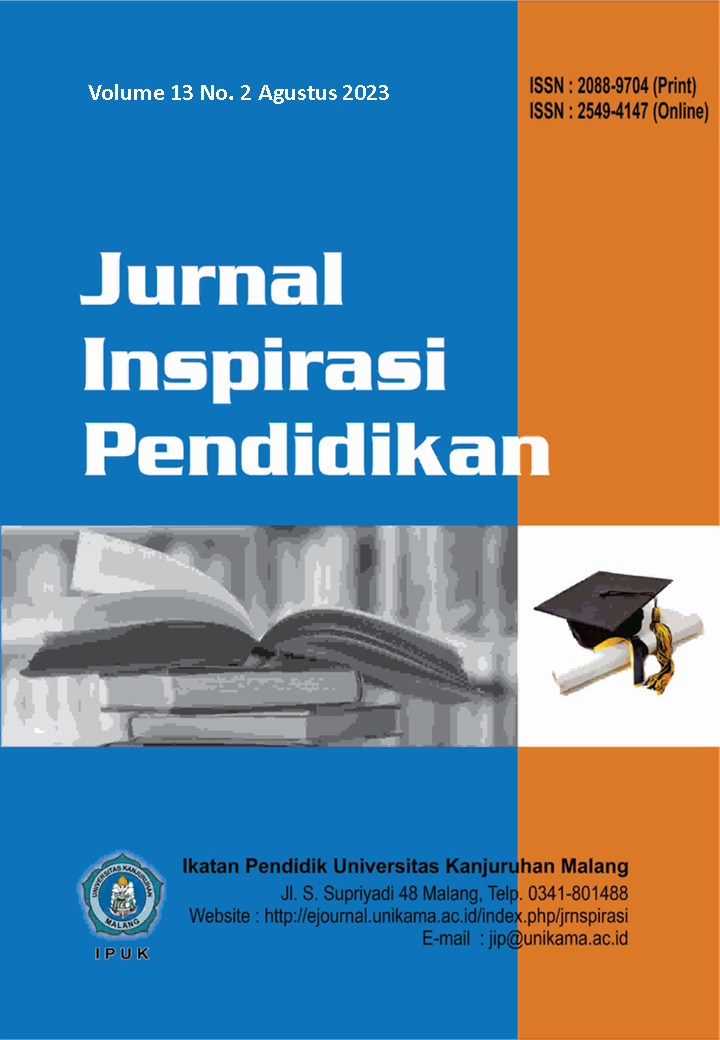Inflectional forms in students’ writing: A point of view from morphological analysis
Main Article Content
Abstract
The objective of this study was to determine the most difficult and dominant inflectional form in students' writing as well as the variables that affect how difficult it is for students to comprehend the function of inflectional forms. This study examined inflectional markings in regular and irregular forms of content words. The design of this study was quantitative descriptive with a population taken from the 3rd-semester students of the English Education Study Program of Tadulako University who have enrolled Grammar subject. The sample of this study was 154 students of the 3rd-semester students by using a simple random sampling technique. The instruments to collect the data were a test and a questionnaire. The results of the data analysis show that: (1) the most difficult form of inflectional forms used by the students was suffix -est as superlative degree, (2) the most dominant form of inflectional forms used by the students was the suffix -ing as progressive marker, (3) there were two factors influencing the students’ difficulty in using the function of inflectional forms which were internal factors. The test results indicate that students lack sufficient knowledge of tenses, as they are unable to apply the present, past, or past participle tenses.
Article Details

This work is licensed under a Creative Commons Attribution-ShareAlike 4.0 International License.
The journal allows the author(s) to hold the copyright without restrictions.
References
Adam, M. O. K., & Eljack, N. S. A. (2020). Investigating Morphological Problems Encountered by EFL University Students in Using Inflectional Morphemes. SUST Journal of Linguistic and Literary Studies, 21(January), 35–43. http://repository.sustech.edu//handle/123456789/25212
Bhardwaj, P. (2019). Types of sampling in research. Journal of the Practice of Cardiovascular Sciences, 5(3), 157. https://doi.org/10.4103/jpcs.jpcs_62_19
Creswell, J. W. (2009). Research Design; qualitative, quantitative, and mixed methods approaches (Third Edition). In SAGE Publications, inc. (Third Edit, Vol. 20, Issue 2). https://doi.org/10.1080/14675980902922143
Fajar, D. R., Niku, I., & Hardianti, S. (2021). Gambaran Tingkat Pengetahuan Sikap Dan Perilaku Masayarakat Terhadap Upaya Pencegahan Covid-19 Di Desa Jenetallasa Kabupaten Gowa. Jurnal Farmasi Pelamonia, 01(1), 44–51.
Fitria, T. N. (2020). An Analysis of Derivational and Inflectional Morpheme in Selected News From Tempo.Co. Rainbow: Journal of Literature, Linguistics and Cultural Studies, 9(2), 146–155. https://doi.org/10.15294/rainbow.v9i2.40348
Ifadloh, N., Najerin, M. R., Nufus, Z., & Ulum, M. (2022). An Analysis of Inflectional Morphemes in a Short Story “The Child’s Story” by Charles Dickens. SALEE: Study of Applied Linguistics and English Education, 3(2), 110–123. https://doi.org/10.35961/salee.v3i2.330
Kusnadi, E. (2011). Fishbone diagram dan langkah-langkah pembuatannya. Wordpress.Com.
Masfufah, D. (2022). Inflectional and Derivational Analysis on Affixes in Justin Bieber’s Album “Purpose.” Jurnal Dialektika Program Studi Pendidikan Bahasa Inggris, 10(1), 38–55.
Novzalia, N. A., & Sari, S. Y. (2022). An Analysis of Students ’ Ability in Using Degrees of Comparison in Adjective and Adverb at English Language Education Program of UNP. Journal of English Language Teaching, 11(4), 629–646. https://doi.org/10.24036/jelt.v11i4.120456
Purba N. S. (2021). A Descriptive Quantitative Study of Students’ Anxiety in Reading and Writing in Learning English at the Eighth Grade of Mts Hadharatul Islamiyah Sipispis. JADEs Journal of Academia in English Education, 2(1), 93–109. https://doi.org/10.32505/jades.v2i1.3262
Qadrie I. H. AL., Yuliana Y. G. S., Urai S. (2001). Students’ Perceptions on the Use of Mind Vector. Jurnal Pendidikan Dan Pembelajaran Khatulistiwa, 1–11.
Rezeki, T. I., & Sagala, R. W. (2019). a Morphological Analysis of Derivational and Inflectional Morphemes. Serunai : Jurnal Ilmiah Ilmu Pendidikan, 5(2), 159–162. https://doi.org/10.37755/sjip.v5i2.232
Shusantie, M. A. (2011). AN ANALYSIS ON THE STUDENTS ’ MASTERY OF DEGREES OF COMPARISON (A Case Study at Second Grade Students (VIII.10) of SMPN 3 Tangerang Selatan).
Sunandar, A. (2022). Analysizing Errors of Inflectional Affixes on Students’ Writings. JETAL: Journal of English Teaching & Applied Linguistic, 4(1), 38–45. https://doi.org/10.36655/jetal.v4i1.777
Wahyuningtyas, E. W., & Bram, B. (2018). Basic Tense Problems of the First Semester Students of English Language Education Study Program. IJIET (International Journal of Indonesian Education and Teaching), 2(2), 147–153. https://doi.org/10.24071/ijiet.v2i2.1509

